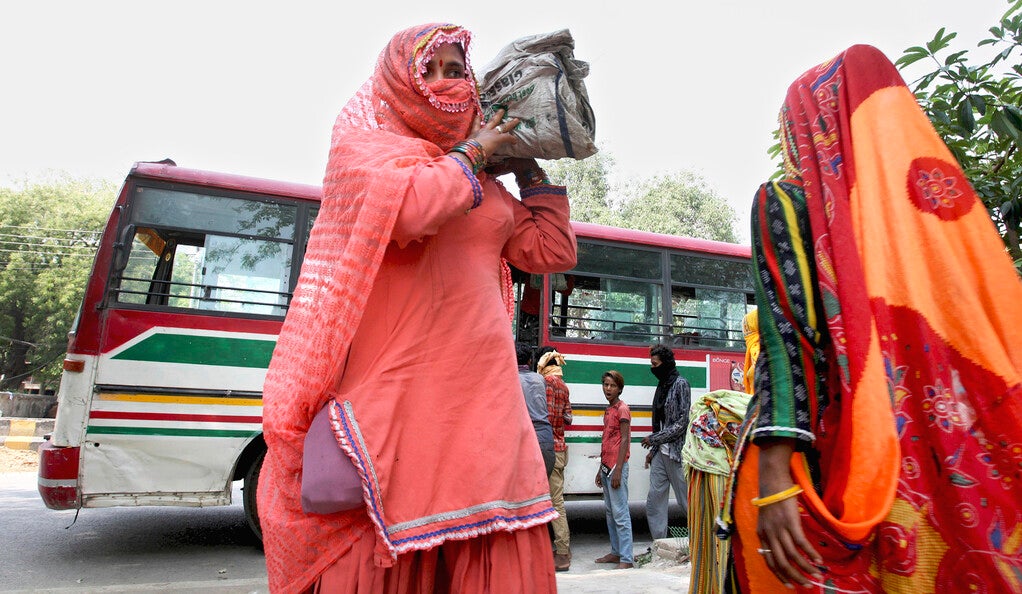Documenting the pandemic struggle of India’s ‘invisible workforce’

(Photo by Ritesh Shukla/NurPhoto via AP)
On March 25, 2020, India abruptly enacted a weeks-long nationwide lockdown to stop the spread of the coronavirus. The measure, implemented with less than four hours’ notice, forced millions of migrant workers to leave the cities where they made their living and return to their homes in rural areas without jobs or access to food, shelter, and other basic needs.
To understand how the lockdown and other pandemic-related challenges affected migrant workers, researchers from Inclusion Economics at Yale University — a collaboration between the Economic Growth Center and the MacMillan Center — quickly launched a large-scale research-policy project in two of India’s poorest rural states, Bihar and Chhattisgarh, in collaboration with government officials.
Over 15 months, the researchers surveyed more than 4,600 displaced migrants to better understand how they were coping through the pandemic — during both the initial lockdown and then during the subsequent Delta wave that devastated the country. As they gathered data, the researchers shared it with Indian policymakers, who were working to support the displaced migrants. Their findings, published recently in eClinicalMedicine, reveal that these migrants faced persistent hardships, including unemployment, food insecurity, and the inability to return to their jobs in the cities more than a year after the lockdown ended, with women faring worse than men.
“The pandemic put into sharp focus the constraints placed on women in India — their agency and their choice of whether to work and earn their own money,” said Rohini Pande, faculty director at the Economic Growth Center, co-founder of Inclusion Economics, and a co-author of the study. “It’s critical that we gather evidence on these constraints and how to remove them, rather than just hoping that economic growth will do the trick. It hasn’t in the past.”
Two of the study’s coauthors, Jenna Allard, assistant director of Research and Policy at Inclusion Economics, and Charity Troyer Moore, Inclusion Economics co-founder and director for South Asia economics research at MacMillan, recently spoke to Yale News about what they learned. The interview has been edited and condensed.

How did you and your colleagues respond to the news of India’s abruptly implemented and highly restrictive lockdown?
Jenna Allard: When the lockdown started, there was a huge internal migration of at least 10 million people trying to return to rural states. It was an immediate humanitarian crisis. There just wasn’t an effective safety net in place for migrants who had been living in cities for years. We reached out to the policymakers we work with in two states to see what we could do to help. They know we do data-related work and they asked us to help them better understand what was happening to migrants who were returning home. Our study, especially in its early stages, was intended to help officials make informed decisions about the types of services that they could provide to the returning migrants.

Charity Troyer Moore: Our previous research focused a lot on gender because women in India have been dropping out of the labor force at a very rapid rate. COVID was another situation entirely. It’s had interesting dynamics in terms of the gendered implications for female labor force participation, but obviously the biggest labor-force dislocation through COVID in India was the migrant displacement that occurred after the prime minister announced with little notice that the entire country was going on a nationwide lockdown.
We wanted to learn what was happening to people since that first lockdown. This paper fills a gap because it shows that in the immediate aftermath of the lockdown, people were hungry, and they couldn’t access social safety net benefits like cash or food. Unfortunately, our study documents that a lot of people really struggled to return to life as normal. Up to 15 months later, things still were still not going well for these people who were vulnerable to begin with.
What do we know about India’s population of internal migrants?
Allard: It’s challenging to measure exactly how many internal migrant workers there are within India, but some estimates suggest there are 80 to 100 million people essentially living outside of their regular place of residence in order to work. Some of that is temporary or seasonal migration from rural areas when there isn’t agricultural work and people struggle to make ends meet. Some of it is more permanent migration that acts as a channel to upward mobility and economic opportunity.
Moore: When anyone who grows up in the United States thinks of migrants, they picture someone coming from a foreign country, not someone who moved from California to Connecticut. Internal migration in India is an entirely different phenomenon. Someone who comes from, say, rural Bihar, a poor state in the east, is going to speak a different language, eat different food, and even have different holidays from people living in the capital, Delhi.
Migrants from rural areas are often the invisible force holding up cities. They’re the construction workers who are building skyscrapers and the huge apartment complexes that are going up in Delhi and Mumbai. They are providing services like domestic help and housecleaning. When the lockdown happened, India discovered the importance of this invisible workforce. People in urban areas realized how much they depended on migrant workers.
How did you survey the migrant workers?
Moore: We reached out to migrants using phone numbers they shared as they returned to their rural villages, calling and surveying them as they returned home and then at additional points through the pandemic.
Allard: Because we used phone surveys, migrant workers returning from many different places to nearly every district in both states were represented in our sample. Phone surveys enabled us to follow people over four different surveys.
Of course, phone surveys have limitations in terms of who we can reach, particularly people who lack phones or access to phones, especially women. But we did offer participation incentives in terms of phone credits to encourage people to continue to be involved in the surveys to prevent attrition and track people over the 15-month period.
What were the key findings?
Allard: The persistence of the lockdown’s negative effects on migrants is the primary finding. They were lingering even 15 months after the first lockdown ended. After 15 months, we see men earning 40% and women less than 28% of their pre-lockdown income. By January 2021, 45% of both men and women still were saying that they were reducing consumption to make ends meet. We see people going back into agriculture, which is very low-wage work in primarily rural areas. The study shows the importance of mobility in allowing migrant workers to recover wages. Migrants needed to travel to different labor markets to reconnect with old employers or work in sectors that pay higher wages.
The gender gaps are the second key finding. Every indicator, including remigration, reentry into pre-pandemic employment, or reentry into the labor market at all, exposed significant gaps between men and women. There were wide gender gaps in earnings, food insecurity, and general well-being, too.
What are the policy implications?
Allard: First, it was important to give policymakers a sense of the magnitude of the lockdown’s consequences. In a future pandemic, when policymakers are considering some form of lockdown, they’ll know to consider what sort of public communication and services are needed to protect migrant workers and other vulnerable populations. There are a lot of administrative barriers to accessing government benefits, especially for mobile and marginalized populations. Policymakers can consider ways to remove those obstacles.
There are also implications for policies to help people reenter the labor market. Those policies should be gender sensitive because women seem to face greater barriers than men. Additionally, there are probably regulatory implications in terms of basic labor laws and protections. Many migrant workers are employed casually, which causes problems. For example, they might lack the ability to procure backpay, which presents serious issues when a lockdown forces them to return home with short notice and they’re short of cash.
Moore: One thing I’d add is that as we were getting the survey results, we were channeling that information to policymakers. We were able to tell the people in charge of the migrant issue following the lockdown that “X” number of people are saying they are struggling to access essentials they need. That was a policy-relevant takeaway in real time that we immediately shared with our government partners to help inform their response.
To read a full research summary on this paper, visit the Yale Economic Growth Center website.
Media Contact
Bess Connolly : elizabeth.connolly@yale.edu,